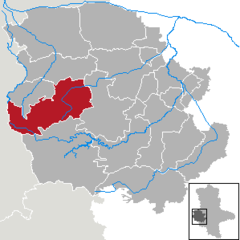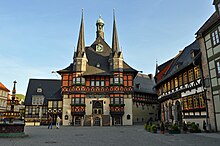Wernigerode
Wernigerode is located southwest of Halberstadt, and is picturesquely situated on the Holtemme river, on the northern slopes of the Harz Mountains.
The town lies at about 250 metres (820 ft) above sea level (NN) on the northeastern flank of the Harz Mountains in central Germany, at the foot of their highest peak, the Brocken, on the B 6 and B 244 federal highways and on the railway line from Halberstadt to Vienenburg that links the cities of Halle (Saale) and Hanover.
The River Holtemme flows through the town and, not far from its western gate, it is joined by the Zillierbach stream, which is also known as the Flutrenne near its mouth.
The town's borough includes Hasserode, Nöschenrode, the residential estates of Stadtfeld, Burgbreite and Harzblick as well as the villages of Benzingerode, Minsleben, Silstedt, Schierke and Reddeber.
The Northern Harz Boundary Fault crosses the borough along which runs the watershed between the Weser and Elbe rivers.
The climate, more precisely the amounts of precipitation and temperatures, are influenced by the orographic rainfall caused by the Harz Mountains.
Because the town lies in the rain shadow (leeward side) of the Harz, less precipitation falls here than in similar temperate regions without the protection of a mountain range.
After World War II, Wernigerode was included in the new state Saxony-Anhalt within the Soviet occupation zone (relaunched in October 1949 as the German Democratic Republic/East Germany).
According to the latest research – for example, by Eduard Jacobs and Walther Grosse – there were no early relations with the Abbey at Corvey (Weser) and the abbot there, Warin, instead the town name suggests it was a protected clearance settlement.
At the time of the first settlelement there was still ancient forest, typical of the Harz, on the heights of the Klint, which had first to be cleared, hence the suffix rode in the town name which means 'clearing'.
As a result of the immigration of new townsfolk from the surrounding villages a new settlement, later called Neustadt, grew up on the northeastern edge of the old town.
The counts of Wernigerode, who can be traced back to the early 12th century, were successively vassals of the margraves of Brandenburg (1268), and the archbishops of Magdeburg (1381).







